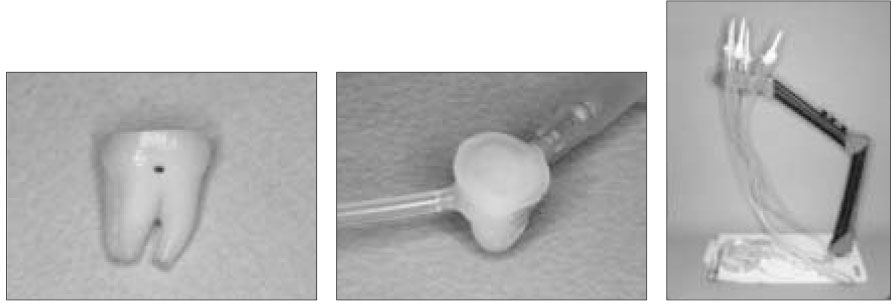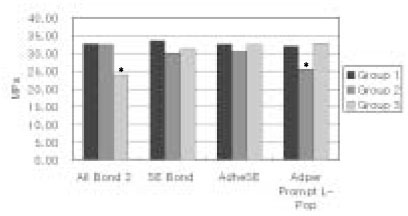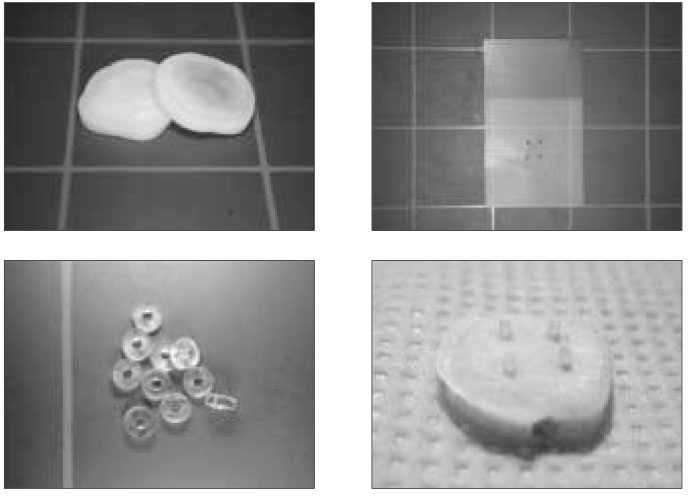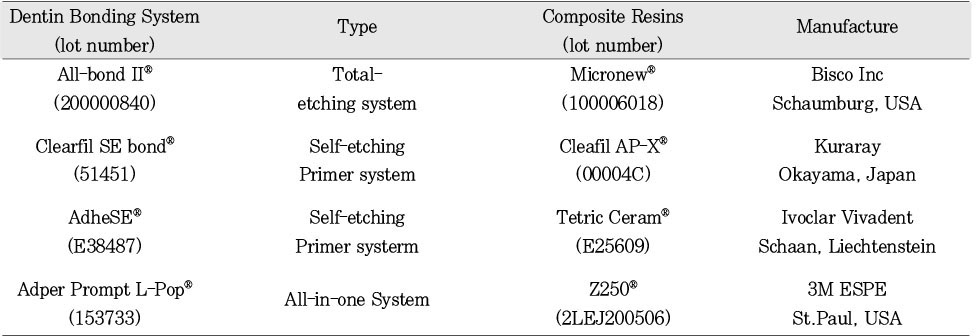Articles
- Page Path
- HOME > Restor Dent Endod > Volume 29(4); 2004 > Article
- Original Article Micro-shear bond strength to dentin under simulated pulpal pressure
- Yun-Jung Song, Sung-Ho Park
-
2004;29(4):-345.
DOI: https://doi.org/10.5395/JKACD.2004.29.4.339
Published online: July 31, 2004
Department of Conservative Dentistry, College of Dentistry, Yonsei University, Korea.
- Corresponding author: Sung-Ho Park. Department of Conservative Dentistry, College of Dentistry, Yonsei University, 134 Shinchon-Dong, Seodaemoon Gu, Seoul, Korea, 120-752. Tel: 82-2-361-8709, Fax: 82-2-313-7575, sunghopark@yumc.yonsei.ac.kr
Copyright © 2004 Korean Academy of Conservative Dentistry
- 570 Views
- 1 Download
Abstract
- The aim of this study was to measure and compare the micro shear bond strengths of the following dentin bonding systems to the dentin surfaces under simulated pulpal pressure; All Bond 2®, Second®, AdheSE®, Adper Prompt L-Pop®. The occlusal surfaces of 180 extracted human molars were prepared so the dentin bonding surfaces could be exposed. The teeth were randomly assigned to 3 equal groups of 60 each and subdivided. The dentin surfaces were treated with the above mentioned bonding system and resin composite cylinders were built up under a simulated pulpal pressure when saline (Group II) or diluted bovine serum (Group III) was used as the pulpal fluid. As a control, the same procedures were performed in the dried dentin surfaces (Group I). After one day of storage in water, the micro shear bond strengths were measured using an EZ tester. Group II and III showed significantly lower shear bond strength than Group I statistically (p < 0.05). SEbond® and AdheSE® showed no difference among the different dentin condition. In the Adper Prompt L-Pop®, a simulated pulpal pressure were applied to the specimens using diluted bovine serum, which showed a higher strength than the specimens in which saline was used (p < 0.05).
- 1. Causton BE. Improved bonding of composite restorative to dentin. Br Dent J. 1984;156: 93-95.ArticlePubMedPDF
- 2. Komatsu J, Finger W. Correlation of early bond strength with margin gaps. Dent Mater. 1986;2: 257-262.PubMed
- 3. Retief DH. In vitro investigation and evaluation of dentin bonding agents. Am J Dent. 1988;1: 176-183.PubMed
- 4. Suzuki T, Finger WJ. Dentin adhesives: Site of dentin versus bonding of composite resins. Dent Mater. 1988;4: 379-383.PubMed
- 5. Tagami J, Tao L, Pasheley DH. Correlation among dentin depth, permeability, and bond strength of adhesive resins. Dent Mater. 1990;6: 45-50.ArticlePubMed
- 6. Derkson GD, Pashley DH. Microleakage measurement of selected restorative materials: a new in vitro method. J Prosthet Dent. 1986;56: 435-440.PubMed
- 7. Pashely DH, Nelson R, Willians EC. Use of dentine-fluid protein concentration to measure pulp capillary reflection coefficients in dogs. Arch Oral Biol. 1981;26: 703-710.PubMed
- 8. Prati C, Pashley DH, Montanari G. Hydrostatic intrapulpal pressure and bond strength of bonding systems. Dent Mater. 1991;7: 54-58.ArticlePubMed
- 9. Tao L, Tagami J, Pashley DH. Pulpal pressure and bond strength of SuperBond and Gluma. Am J Dent. 1991;4: 73-76.PubMed
- 10. Davidson CL, Abdalla AI, De Gee AJ. An investigation into the quality of dentine bonding systems for accomplishing a durable bond. J Oral Rehabil. 1993;20: 291-300.PubMed
- 11. Augustin SJ, Paul H, Schärer P. Perfusing dentine with horse serum or physiologic saline: its effect on adhesion of dentine bonding agents. J Oral Rehabil. 1998;25: 596-602.ArticlePubMedPDF
- 12. Pioch T, Staehle HJ, Schneider H. Effect of intrapulpal pressure simulation in vitro on shear bond strengths and hybrid layer formation. Am J Dent. 2001;14: 319-323.PubMed
- 13. Nikaido T, Burrow MF, Tagami J, Takatsu T. Effect of pulpal pressure on adhesion or resin composite to dentine: bovine serum versus saline. Quintessence Int. 1995;26: 221-226.PubMed
- 14. Van Hassel HJ. Physiology of the human dental pulp. Oral Surg Oral Med Oral Pathol. 1971;32: 126-134.PubMed
- 15. Belli S, Unlü N, Ozer F. Bonding strength to two different surface of dentin under simulated pulpal pressure. J Adhes Dent. 2001;3: 145-152.PubMed
- 16. Perdigao J, Swift EJ, Cloe BC. Effect of etchant,k surface moisture, and resin composite on dentin bond strength. Am J Dent. 1993;6: 61-64.PubMed
- 17. Yamauchi J. Study of dental adhesive resin containing phosphoric acid methacrylate monomer. J Jpn Dent Mater. 1986;5: 144-154.
- 18. Meerbeek V, Vargas M, Inoue S, Yoshida Y, Peumans M. Adhesives and cements to promote preservation dentistry. Oper Dent Suppl. 2001;6: 119-144.
- 19. Tay FR, King NM, Suh BI, Pashley DH. Effect of delayed activation of light cured resin composite on bonding of all-in-one adhesives. J Adhes Dent. 2001;3: 207-225.PubMed
REFERENCES
Tables & Figures
REFERENCES
Citations
Citations to this article as recorded by 

Micro-shear bond strength to dentin under simulated pulpal pressure



Figure 1
Simulation of pulpal pressure
Figure 2
Tooth slice and specimen hole
Figure 4
Micro-shear bond strength of dentin adhesive systems
*statistically significant (p < 0.05)
Figure 1
Figure 2
Figure 4
Micro-shear bond strength to dentin under simulated pulpal pressure
Materials used in the present study
Micro-shear bond strength (MPa)
(Mean ± Standard deviation)
*statistically significant (p < 0.05)
Two-way ANOVA between the surface conditions and dentin bonding systems
*F-value was significant at the 95% level of confidence.
Table 1
Materials used in the present study
Table 2
Micro-shear bond strength (MPa)
(Mean ± Standard deviation) *statistically significant (p < 0.05)
Table 3
Two-way ANOVA between the surface conditions and dentin bonding systems
*F-value was significant at the 95% level of confidence.

 KACD
KACD






 ePub Link
ePub Link Cite
Cite

